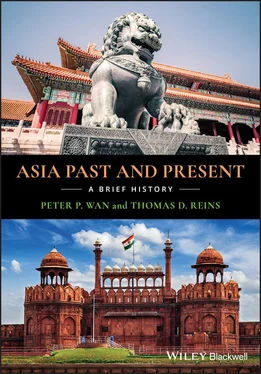1 ...8 9 10 12 13 14 ...41 What do we know about India’s earliest city life? The Indus River, which originates in the Himalayan Mountains, provided reliable access to water for both animal (humans, dogs, cats, cattle, and eventually horses and camels) and plant life (wheat, melons, peas, barley, rice, and other fruits and vegetables). The Indus and its tributaries also supplied dependable flooding that deposited fertile topsoil on nearby cropland. Consequently a plentiful quantity of food made it possible for the rural majority of farmers to support an urban minority of non‐farming occupations. This symbiotic relationship resulted in a community of differing occupations bound together by an attitude of shared interests and values.
The cities, which appear to have been well planned, were divided into two distinct parts: an elevated citadel for the city’s defense and refuge, and the lower city itself, which was organized along a grid pattern. Spacious homes made of brick contained drainage systems, verandas, living/bedrooms, and work areas, thus providing a fair amount of domestic comfort for many inhabitants. High‐quality roads within each city made transportation and travel in the roughly five‐ to six‐square‐mile city relatively easy, while the Indus facilitated contact among the various city‐states (which stretched more than a thousand miles along the river) as well as with the wider world, the gateway to which was the Arabian Sea, into which the Indus flows.
Unearthed artifacts such as pottery, seals, and tools (as well as the absence of some remains) offer clues to some of the thinking and behavior of these early Indians. The lack of remains signifying the presence of palaces strongly argues against the existence of a strong, awe‐inspiring ruler, either in any particular city or among clusters of city‐states that emerged in the ancient civilizations of Mesopotamia, Egypt, and China.
According to one scholar of India, “Trade seals with signs from the Harappan writing system have been found not only in the major cities of the Indus‐Saraswati civilization but also overseas or overland at Ur in Babylon (South Iraq), at Ebla in North Syria and at numerous ports in the ancient Persian Gulf.” 3 Apparently merchants and mercantile activities constituted important parts of the social order in these cities. Moreover, the Indus Valley writing system, seals, and pottery make a strong statement of orthographic and religious continuity. By 2000 BCE along the river corridor, it appears that Indus Valley civilization had reached its point of greatest development.
How did Harappan civilization collapse? Several theories, none of which are mutually exclusive, attempt to explain the disappearance of the numerous city‐states for nearly 3500 years. One speculation asserts that prolonged drought, evidenced by the drying up of the Saraswati River, compelled Indus Valley residents to migrate east in search of a more farmer‐friendly environment. Another theory stresses the likelihood of massive flooding either caused by unusually large amounts of Himalayan snowmelt or due to a tsunami from the sea. Given the nearness of the city‐states to the Indus or its tributaries, such scenarios could have spelled doom for urban occupants. As well, a massive earthquake in this earthquake‐prone area could have destroyed the region. Furthermore, the Aryan invaders from Central Asia had the potential of overrunning these hundreds of city‐states. And finally, any combination of these catastrophes, not all simultaneously but over time, could have eroded and then destroyed the framework of Indus Valley civilization.
Ancient Chinese Civilization
As in the other ancient civilizations of Mesopotamia, Egypt, and the Indus Valley, the initial stages of civilization in China originated in a dry region with easily worked soil near a large river. The Yellow River and its tributaries supplied both sufficient water for irrigation and regular annual flooding that deposited new topsoil on existing fields, an agricultural combination that generated the abundant harvests capable of supporting a large non‐farming population. Exactly how and where Chinese civilization began is unclear, but social scientists generally agree that just after 2000 BCE a complex culture capable of constructing public buildings, crafting writing, using bronze, mobilizing manpower, and domesticating horses for chariot warfare and other tasks appeared in the vicinity of the Yellow River. As in the case of India, questions arise about whether Chinese civilization started on its own or if it owed its creation or at least much of its development to outside influences. Thus, the chariot and its similarity to those in other parts of Eurasia seem to indicate external contact. There is also dispute as to whether China’s first historical dynasty, the Shang (ca. 1650–1050 BCE), in fact was preceded by an earlier dynasty. Growing evidence indicates the likelihood of an earlier dynasty the Chinese call the Xia.
Whatever future research authenticates, current evidence reveals the existence of a Shang Dynasty by at least the seventeenth century BCE, probably headquartered in today’s Henan Province but extending across a good part of the North China Plain. An emperor or king, whose functions appear to have been both political and religious, presided over a central government. This ruler likely had to share power with a rural landowning elite but nevertheless could mobilize manpower and materials for numerous projects. Some of the larger undertakings included the building of palaces, city walls, and burial facilities for rulers, as well as the deployment of a host of talent that would organize laborers and artisans to construct the facilities. Priestly advisors or diviners or shamans provided the ruler with insight about the supernatural, chiefly by interpreting cracks on oracle bones. Since the ruler was linked to the supreme deity, he needed to know what to do or refrain from doing. Upsetting god might well result in one’s government itself being upset.
The Shang Dynasty established the initial foundation for the ideal of central government in China that survives in amended form down to the twenty‐first century. This central government model did not always operate successfully, failing to some extent between dynasties for greater or lesser periods of time. Unsuccessful central government rule occurred during times when dynasties were headed by weak rulers or when China’s neighbors, usually nomadic ones to the north, invaded and temporarily took control. The principle of central direction orchestrated by rulers connected to divinity typically remained a Chinese political and intellectual ideal. By contrast, India seldom experienced central government rule by Indians. With the exception of two dynasties, the Mauryan (321–185 BCE) and the Gupta (320–540 CE), India either remained fragmented, governed by regional monarchs and lesser rulers—think of splintered Europe after the fall of the Roman Empire—or was ruled by foreigners until independence from Britain in 1947.
The Ongoing Influence of India and China in Asia
Yet whether Chinese central government or Indian regional rule, both centers of culture eventually provided guidance for those territories surrounding them. Indian culture remained the chief influence in Central Asia until the arrival of Islam in the eighth century CE and in most of Southeast Asia at least until the arrival of the Europeans. Chinese ideas and institutions served as both a broad outline and frequently a detailed agenda for civilization in Vietnam, Korea, and Japan. From the concept of monarchy to writing systems and educational arrangements, religious attitudes and philosophical outlook, and secular observances and popular culture, India and China served as repositories of culture that adjacent peoples drew upon and modified to suit their particular needs. And by the eighteenth century, China began to influence those territories in Southeast Asia that initially embraced Indian practices. Chinese migrants made their way there in search of employment as least as far back as the Ming Dynasty (1368–1644) and carried with them cultural baggage from the homeland. They brought with them a distinctly Chinese way of looking at the world that competes with Indian practices even today.
Читать дальше












